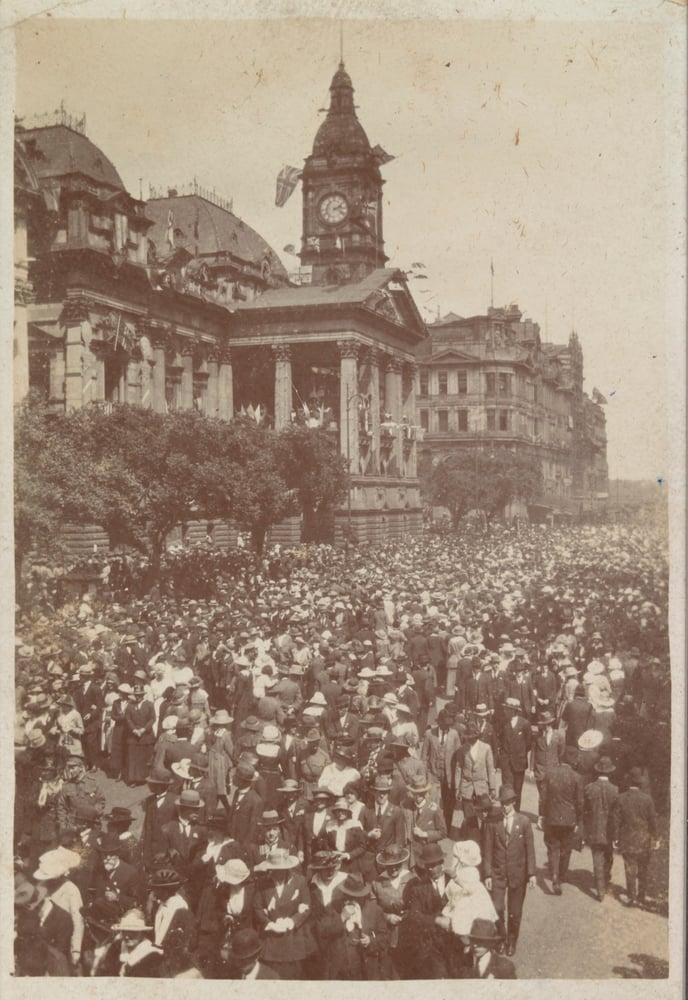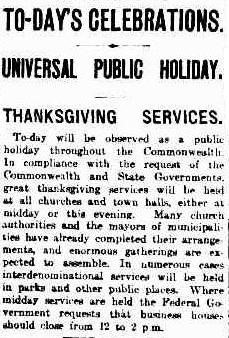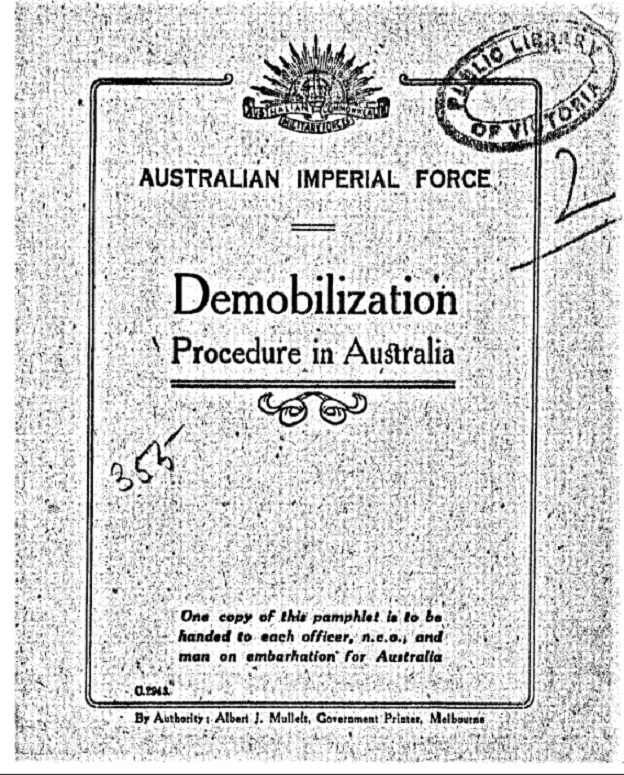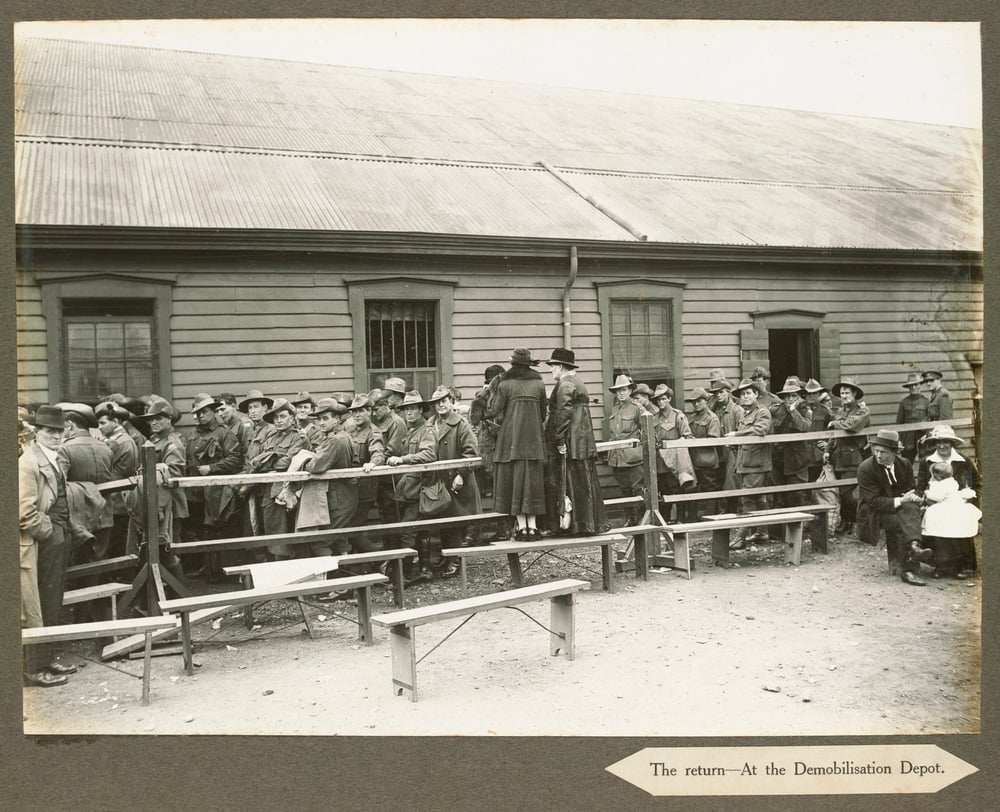Guns on the Western Front fell silent one hundred years ago, at 11am on 11 November 1918, bringing to an end what we remember as the First World War. An Armistice agreement had been signed six hours earlier, at 5am. That same afternoon, the British Prime Minister, David Lloyd George, addressing the House of Commons in London, stated:
Thus at eleven o’clock this morning came to an end the cruelest and most terrible War that has ever scourged mankind. I hope we may say that thus, this fateful morning, came to an end all wars. (Hansard)
The European war armistice between the Allies and Germany was the final of a series of armistices between the Allies and their other antagonists, the Central Powers of Bulgaria, the Ottoman Empire and the Austro-Hungarian Empire.
Victoria learns of the Armistice
As with the beginning of the war, the Armistice was experienced by Victorians with a time difference between Europe and Australia, at 8pm on Monday 11 November, nine hours later from the French time 11am. The news could have been telegraphed to Australia after the armistice was signed at 5am and before 11am when it came into force, but the official telegram to the Australian Governor General in Melbourne is time marked at 9.36pm that evening. This was certainly too late to communicate to the population in general as there was no radio, newspapers had ceased publishing and darkness would be falling before any notices could be printed and posted. As the war historian Charles Bean states, in the Official History of Australia in the War of 1914–1918, the armistice was celebrated on Tuesday 12 November in Australia and all the major photos are taken in daylight and so it could not have been the evening of Monday 11 November.
The library has a number of books on the armistice like Voices from the past: Armistice, 1918 by Paul Kendall, published in 2017, and most of the Victorian newspapers from the war years, 1914-1918 have been digitised so the day can be explored in print. The government decided to proclaim Tuesday a public holiday in the Commonwealth and this announcement is printed on p.5 of The Age on Tuesday 12 November. As Canberra had yet to be built, Melbourne was still the seat of government in Australia in 1918 and was therefore a major focal point for much that happened.
In France, the five Australian divisions had been pulled off the front line after the major advances of the Battle of Amiens in August, with their last action being an attack on 5 October 1918 – at this point they were exhausted and had to be rested. The euphoria and celebrations instigated by the signing of the armistice quickly segued to the question of returning the AIF troops to Australia.
Repatriation of Australian troops
Ten days after the end of the war, Sir John Monash was called to London on the 21 November to be appointed Director General of the AIF Department of Demobilisation and Repatriation, officially taking command on 4 December. Some of the policy issues and administration dealing with setting up the repatriation system had already been put in place, with the Australian Dept. of Repatriation formally established on the 8 April 1918.
The government and Monash had to oversee and coordinate the return of over 160,000 troops, nurses and other personnel and, in January 1919, Monash issued the pamphlet Demobilisation of the AIF: Things which Australian soldiers ought to know, and organized speakers to tell them what was happening. The State Library has a broad collection of administrative and government material and has digitised some of the key documents as well as photos of returned soldiers.
Songs were popular and widespread at the time, with recording in its infancy, sheet music was heavily used. The Library’s collection of sheet music published during the war archives these now-forgotten songs.

Back home, written and composed by Reg AA Stoneham
Monash’s ability with logistics and organization meant that the troops returned to Australia relatively quickly and, although most were in Europe, there were large contingents in the middle east, some in Persia and Salonika, and others in India including a large number of nurses. The process took a little over a year and, during this time, some soldiers married so the transport also included 18,000 wives and families.

The scars of war
Many of the troops returned to Australia in 1919–20 with battle injuries, various forms of post-traumatic stress disorder (PTSD), then called shell shock, as well as a different view of the world marked by their experience of the war and different cultures. The return to Australia was clearly desired by most but it was also disruptive, traumatic and brought long term social, medical and personal problems that significantly coloured post war life in Australia and echoed down the generations.
This was clearly stated in Patsy Adam Smith’s seminal work The ANZACs in 1978 and has been explored by a range of other writers since that time including Marina Larsson’s Shattered ANZACs: living with the scars of war, published in 2009. This was the dark side of demobilization’s return from war and was paradoxically shared by both the victors and the defeated
The end of the war also saw the release of two UK government reports, The final report of the Dardanelles Commission, 1919, about the military disaster of the Gallipoli campaign, and the 1922 parliamentary paper, Report of the War Office Committee of Enquiry into “Shell-Shock. While these reports were being published, David Lloyd George’s comment, quoted above, was given the lie that the armistice may ‘end all wars’ as British soldiers fought in Russia to assist the White Russians, and the remnant of the Ottoman Empire fought a vicious war to secure defeated Turkey from dismemberment by Greece and Italy in 1921.
Anniversaries
The first anniversary of the armistice in 1919 included a commemorative service in London where 2min of silence was requested by King George V and this was popularly adopted at future commemorations. The minutes of silence had been suggested by several parties including the Australian journalist Edward Honey who worked in Fleet Street. The title ‘Armistice Day’ for the commemoration on 11 November remained until after the end of the second world war when both the Australian and British governments changed the name to ‘Remembrance Day’ to better reflect the commemoration of all war dead, not just those from First World War.
Written by Steven Kafkarisos and Walter Struve, October 2018
More to explore
- Australians in World War One – Research Guide
- First World War – this database can be used by Victorians who have a State Library membership number
- The State Library World War One collection video speaking about the Library’s collection and how it was developed






